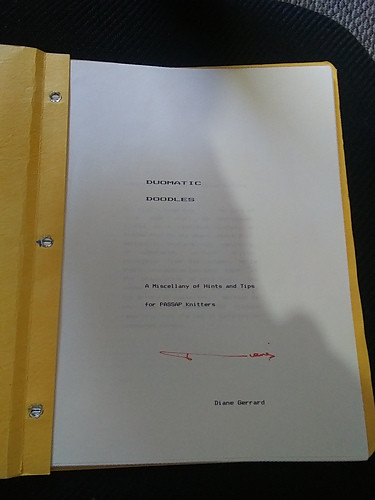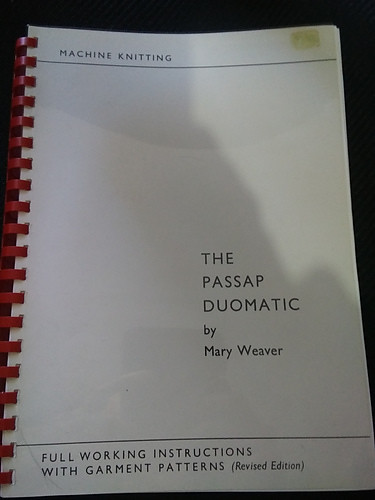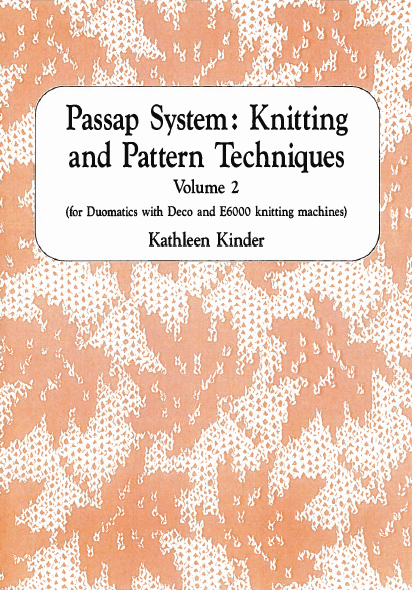These have been kindly provided by etrnlife on Ravelry - these are some Passap publications I don't have so she kindly reviewed them for me.
==
Basic Course For The Passap Knitting Machine, A van der Merwe, 1984, 116 pages
(Her copy was well worn when she got it and the cover is missing.)
A complete resource! Detailed information on how the machine works and everything else. Includes single and double bed knitting, the transfer locks, intarsia, understanding the shaping notations/symbols in the model books, and detailed information for shaping necklines with or without the Deco in use.
Casting on and Binding off, G Bengelsdorf, 1992, 26 pages
As the name implies, the book contains various methods for casting and binding off. Includes the basics, figure 8 bind off, chaining in rib, methods done away from the machine, binding off 3 & 4 color Jaquard, and making the cast on and bind off match.
Charting for the Passap, Sylvia K. Jones, 1987, 23 pages, appears to be self published in a report cover w/plastic slip on spine.
This book seems more about doing the work of the Form Computer for those who do not have one. You are taking an existing pattern, from your choice of source, and adapting your gauge to it. There is no information for measuring your body or adjusting the pattern shape to your needs. Using a calculator to do the math is explained, calculating the pattern schematic curves/slopes to your gauge is included. There are helpful tips on understanding how to count sts from your swatch and how to increase/decrease when doing double bed patterning.
The Passap handbook - Deco, B A Erkovitch, 1988, 106 pages.
Includes a review of the pusher system without the Deco, inner workings of the Deco, and how to use it. there rest of the book is a study format with several lessons pertaining to each stitch type. Deco card #77 is used in the picture examples of each lesson, but Card #19 from the basic pack is suggested as an alternative. The anatomy of the stitch section for each lesson is wonderful in understanding what the machine is doing. Understanding the stitches can help you to go beyond this book. Helpful information is included on 4 color knitting, single motif placement, and the transfer lock.
Duomatic Doodles, Diane Gerard, 1986, 49 pages
Looks to be self published. My copy is signed and is printed on home computer paper. The cover is a simple 3 prong folder.
This book has many hints and tips. This book is technical with no patterns. It discusses the usual how to use the machine and includes transfer methods, increase/decrease methods, necklines/bands, cast off methods, reading and understanding diagrams, calculating your own patterns and more.
Duomatic knitting, M Weaver, 1986, 175 pages.
This book has more patterns and information related to garment construction. There are several patterns and Deco card designs. Information includes longstitch, intarsia, jacquard, use of cast on comb and weights. The patterns include men, women, and children.
Primer for the Passap, Sylvia K. Jones, 1986, no page #s, appears to be self published in a report cover w/plastic slip on spine.
This is a collection of garment hint and tips. Information covers hems, casings, knit in edges for arm holes and necklines, short row uses for curved hems/bust darts/sideways knitting, and intarsia. Patterns include Sleeveless vest with knit in trim, sideways and panel skirts, and cabled intarsia sweater.
The Passap Duomatic, M Weaver, 1976, 262 pages.
This book contains a few patterns and loads of detailed help on many topics. Topics discussed are the basics like casting on and stitches, types of yarns, the transfer lock, seaming, cut and sew, button holes, trimmings, etc.
Passap U80, K Fay, 1983, 38 pages
Wonderful Resource for all transfer locks, including the U100(E). This book explains more than the manual and includes five sweater patterns. Three patterns are for ladies, including a Catherine’s Wheel lace pattern, and two patterns are for men.

















